1911 15th Anniversary Egg
Gift Nicholas II to Alexandra Feodorovna
Made in Saint Petersburg
Owner: The Link of Times Foundation, Russia
Height: 13,2 cm
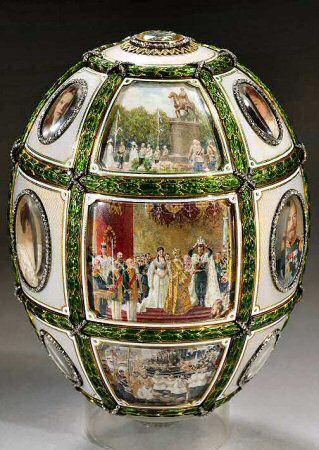
The 1911 15th Anniversary Egg is made of gold, translucent green enamel, opaque white enamel, opalescent oyster enamel, diamonds, rock crystal and watercolor on ivory.
The shell of this red gold Egg is divided into eighteen panels set with 16 miniatures, bordered by green enameled leafage wrapped with diamond-set ribbons at the intersections and enclosing sixteen miniatures by court miniaturist Vasilii Zuiev framed behind rock crystal. Seven oval portrait miniatures of the Imperial family within diamond-set borders and 9 larger panels depicting scenes from the life of Nicholas II. Two oval panels within diamond-set borders beneath the miniatures of Nicholas and Alexandra enclose the dates 1894, the date of the wedding of Nicholas and Alexandra, and 1911, the fifteenth anniversary of the coronation, each date above a ribbon inscribed Fabergé in Cyrillic.
The top of the Egg is inscribed with the Imperial monogram of Alexandra Feodorovna below a table diamond encircled by a diamond-set border, the bottom of the Egg mounted with a diamond also encircled by a diamond-set border.
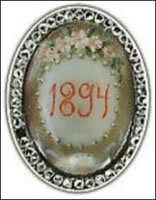
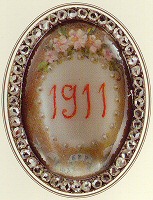
The seven oval portrait miniatures and the top and the bottom of the Egg are enameled translucent oyster over a guilloche ground, The interior of the Egg is marked with the initials of its workmaster, the dates 1908-1917 and the assay mark for St. Petersburg, 72 standard for 18 karat gold.
Below Tsar Nicholas II and the Empress Alexandra Feodorovna
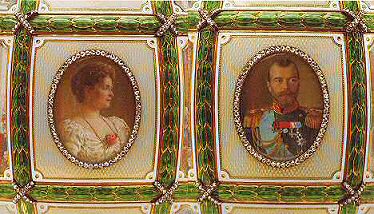

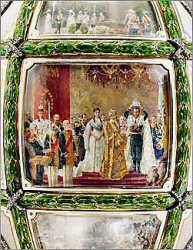
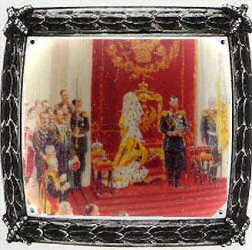
Nine historical scenes from the reign of Nicholas II
The Ceremonial Procession to the Uspensky Cathedral; The Moment of the Holy Coronation and the Ceremonial Reception of the Members of the First State Duma in the Winter Palace
The two scenes from the Coronation festivities of 1896, the procession to Uspensky Cathedral and the Coronation of the Tsar were moments of glory for the Imperial couple. Yet the young Tsarevich Nicholas was unprepared for his adored father's sudden death. This shy, intensely private man, most happy in the circle of his close family was thrust, unwillingly, into the limelight. He was initially terrorized by his overbearing three uncles and disliked his time consuming, frustrating duties. The Coronation ceremonies were followed the next day by the tragic events on Khodynka Meadow with over 1,000 dead, crushed, due to the incompetence of the Governor General of Moscow, the Tsar's uncle Grand Duke Sergei. This was generally interpreted as a bad omen for Nicholas' reign.
Following the humiliating defeat at the hand of the Japanese in early 1905, the cruelly suppressed uprising of January 22, 1905 (Bloody Sunday), the ensuing strikes and the assassination of Grand Duke Sergei, a Manifest was issued on October 30, 1905 transforming Russia from an absolute autocracy into a semi-constitutional monarchy. In May 1906 Nicholas gave his famous speech opening the Duma in the Throne Room, St. George Hall, in the Winter Palace on April 27, 1906. Zuiev's miniature is a copy of the photograph recording this occasion. Sadly, this historic opportunity, which could have changed the course of history and which was joyfully welcomed by many, was missed, when the Duma, after what the Tsar and Tsarina found were too great demands, was dissolved.
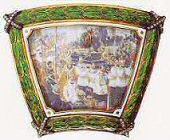
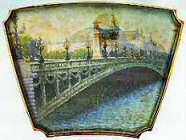
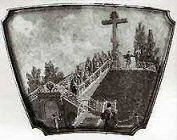
From left to right: The Transfer of the Relics of St. Seraphim of Sarov, The Opening of the Alexander III Bridge in Paris at which His Imperial Majesty was present and The Opening of the Monument in Poltava Commemorating the Two Hundredth Anniversary of the Battle of Poltava.
Transfer of the Relics of St. Seraphim of Sarov
Following the birth of four daughters in 1895, 1897, 1899 and 1901, the Tsar and Tsarina, on the suggestion Philippe Nizier Vachot, a hypnotist and apparent curer of nervous diseases, pressed for the Canonization of Seraphim of Sarov (1759-1833), a hermit and monk associated with many miraculous healings, including of two members of the Imperial family. Zuiev's miniature shows the transfer of the remains of the Saint into the cathedral of Sarov on July 19, 1903 in the presence of the Tsar, who recorded in his diary that they carried the coffin on a litter in a procession this time with the relics visible. “ One felt enormously inspired.” The Tsarina prayed for the Saint's intercession: the long-awaited male heir was born in 1904. She was convinced that it was “ Seraphim who had brought it about.” His birth, greeted with immense relief and joy, was to prove a mixed blessing. The ill health of the hemophiliac boy brought Rasputin on the scene, whose influence on the Tsarina and on Russian politics was to speed up the downfall of the Romanov dynasty .
The story goes that Seraphim reputedly predicted that his relics would disappear and Russia would then be plunged into a dark abyss. He also claimed his remains would be rediscovered and Russia would awaken to a new time of enlightenment. Seraphim's remains disappeared about 1918 and were relocated in 1990!
Alexander III Bridge Paris
The miniature of the Pont Alexandre III in Paris is shown with the Grand Palais in the background. Both buildings, which still stand today, were finished in time for the opening of the World Fair in early 1900. Nicholas and Alexandra had laid the foundation stone of the bridge in 1896, a visible symbol of the Franco-Russian alliance, among much fanfare. The Tsar and Tsarina were to have inaugurated the finished bridge at the opening of the World Fair on April 14, 1900, but were unable to attend – some said that the Tsarina feared an assassination attempt. Instead, the bridge was inaugurated in their name by the Russian Ambassador, Prince Ouroussov.
The Battle of Poltava
The year 1909 marked the bicentenary of the Battle of Poltava, in which Peter the Great with an army of 42,000 men and seventy-two cannons defeated King Charles XII of Sweden with his 27,000 soldiers and only four cannon on June 27, 1709. Thus ended the Great War of the North, establishing the position of Russia in Europe and giving Russia control over the Balkan States. To mark the occasion a large stone cross was erected over the so-called Swedish Grave, a mound sixty-five feet high, where the 1,345 Russian soldiers who died in the battle were buried. The remaining 16,000 Swedes surrendered three days after the battle. A major celebration was held in Poltava in 1909 to commemorate the event.
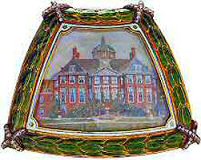
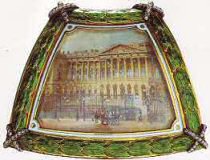
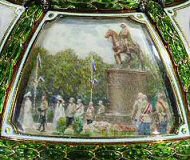
From left to right: Huis ten Bosch in the Hague – the site of the first Peace Conference, The Museum of the Emperor Alexander III in Saint Petersburg and The Unveiling of the Peter the Great Monument in Riga.
Paleis Huis ten Bosch
Huis ten Bosch at The Hague, the house at which the Peace Conference called by Queen Wilhelmina and Nicholas II in May 1899 was held. The participants were to agree on rules of warfare and establish a permanent court of arbitration. At this time the Tsar earned himself the title of “The Peacemaker.” Sadly, the arms race deplored by Nicholas was to involve the Tsar himself in a disastrous Russo Japanese War and lead him to fight his own belligerent cousin Kaiser Wilhelm II at the side of Russia's great French ally during the First World War, which ended with the disappearance of both great Empires. However the conference managed to establish the permanent court of arbitration, which still exists today!
Alexander III Museum
The Museum of Tsar Alexander III or Russian Museum is located in the New Michael Palace erected in 1819-1825 in the Tuscan style from designs by Carlo Rossi. It was built for the brother of Alexander I, Grand Duke Michael Pavlovich. In 1893 Tsar Alexander III decided to give St. Petersburg a museum of Russian art, the equivalent to Moscow's Tretiakov Gallery. After his father's death, Nicholas II saw the project to its completion. The building was converted into a museum beginning in 1895 and opened in 1898. It originally contained a collection of 2,500 Russian works of art assembled from Imperial palaces, the Hermitage, the Academy of the Arts and private collections and was open free to the public. Among its many treasures were paintings by Repin, Konstantin Makovsky, Surikov and Serov. Its first director was Grand Duke George Michailovich assisted by Count D. I. Tolstoi. Today the museum contains over 370,000 works of art.
Statue Peter the Great, Riga
Riga, situated at the mouth of the Dvina on the Baltic Sea was originally a German Hanseatic town, then Polish, and was captured by Gustavus Adolphus, King of Sweden, in 1621. In front of the old town at the end of the Alexander Boulevard stands a bronze equestrian statue of Peter the Great by Schmidt-Cassel, which was unveiled in 1910. It commemorates the victory of the Russian armies under General Sheremetiev on July 4, 1710 over the Swedes after an eight months siege to the city. Following the Peace of Nystadt in 1721, Livonia and its capital, Riga, were incorporated into the Russian empire. In the early twentieth century, Riga was, after St. Petersburg, the most important Russian commercial and industrial town on the Baltic Sea, with a population of half a million inhabitants, exports worth 225 million rubles and imports of 155 million rubles.
The statue was originally erected in Riga in 1910. But in 1915, during World War I, it was taken from its pedestal to be delivered to Russia as metal. It could have been melted into bullets had the boat carrying it from Riga to St. Petersburg not sunk off the coast of Estonia. In the early 1930s, a team of Estonia divers lifted it from the ocean floor and sold it back to Riga, where it remained as an ambivalently received guest. In 1994, Riga's then-mayor decided not to dismantle it because of its historical significance. Early 2002 the statue was taken down for renovations for Riga's 800th birthday celebrations when the city's Duma made the decision to send it to St. Petersburg for the city's 300th birthday in 2003.
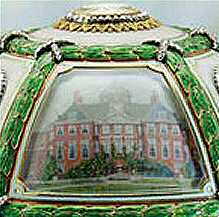
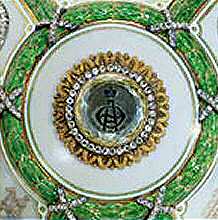
The top of the Egg with Huis ten Bosch and the monogram of Alexandra Feodorovna
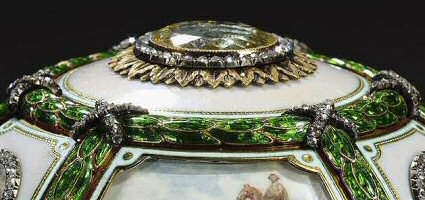
Background information
The seven exquisite oval family miniatures by Vasilii Zuiev show all the family united, the apparently happy parents, the four beautiful daughters and the handsome son. Few were those who were initiated into the intense suffering of the parents occasioned by the Heir to the Throne's hemophilia. The boy's illness would in due course bring Rasputin on the scene with tragic consequences for the Imperial family.
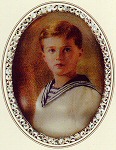
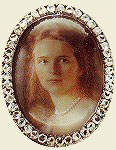
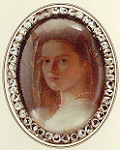
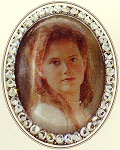
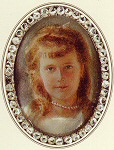
Alexis Nikolaevich, Grand Duchesses Olga Nicholaievna, Tatiana Nicholaievna, Maria Nicholaievna and Anastasia Nicholaievna
It is not known how the 15th Anniversary Egg came to the West. Probably is was sold by a high Russian official to a friend in the United States, or it may have been bought by the Hammer Galleries of a Soviet trade official. 1966 sold by A la Vieille Russie to the Forbes Magazine collection, New York where it became Malcolm Forbes' favorite Egg. The Forbes Magazine Collection was the only collection in the world to have two Imperial Easter Eggs from the same year. They were the 1911 15th Anniversary Egg and the 1911 Bay Tree Egg. February 2004 sold by the Forbes' family to the Vekselberg Foundation/The Link of Times Foundation, Russia.
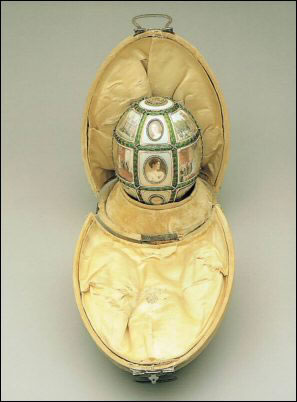
The 15th Anniversary Egg in its Case
(Courtesy Romanov News)
Read more: http://www.treasuresofimperialrussia.com/e_chap10_fifteenth.html
(Link no longer active)
Page updated or corrected: 2018-03-30
